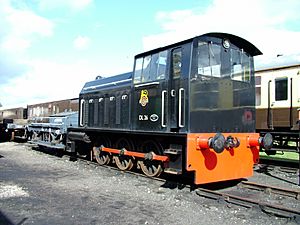British Rail Class 05 facts for kids
Quick facts for kids British Rail Class 05 |
|
 |
|
| This preserved locomotive at the Didcot Railway Centre is an industrial example, built to the same design as the British Rail Class 05 | |
| Power type | Diesel-mechanical |
|---|---|
| Builder | Hunslet Engine Co. |
| Build date | 1955–1961 |
| Configuration | 0-6-0 |
| UIC classification | C |
| Gauge | 4 ft 8 1⁄2 in (1,435 mm) |
| Wheel diameter | 3 ft 4 in (1.016 m) |
| Minimum curve | 2 chains (40 m) |
| Wheelbase | 9 ft 0 in (2.74 m) |
| Length | 25 ft 4 in (7.72 m) |
| Width | 8 ft 3 in (2.51 m) |
| Height | 11 ft 0 in (3.35 m) |
| Locomotive weight | 30.9 long tons (31.4 t) |
| Fuel capacity | 300 imp gal (1,400 L; 360 US gal) |
| Prime mover | Gardner 8L3 |
| Engine type | Four-stroke diesel |
| Transmission | Hunslet 4-speed gearbox, Hunslet patent friction clutch, Hunslet reversing gearbox and final drive. |
| Top speed | 18 mph (29 km/h) |
| Power output | Engine: 204 hp (152 kW) |
| Tractive effort | Maximum: 14,500 lbf (64 kN) |
| Train heating | None |
| Locomotive brakeforce | 14 long tons-force (139 kN) |
| Train brakes | Vacuum |
| Career | British Railways |
| Number in class | 69 |
| Number | 11136-11176; later D2550-D2618; later 05001 |
| Axle load class | RA 2 |
| Retired | 1966–1968 (except D2554) |
The British Rail Class 05 was a type of small train engine used by British Railways. These engines were called "shunters" because their main job was to move railway wagons and carriages around in train yards. They were built between 1955 and 1961.
These engines were known as "diesel-mechanical" locomotives. This means they used a diesel engine to power their wheels, similar to how a car engine works. They had a special design called "0-6-0", which means they had six driving wheels and no smaller wheels at the front or back.
Contents
What was the British Rail Class 05?
The British Rail Class 05 was a group of 69 small but strong diesel shunting locomotives. They were built by a company called Hunslet Engine Company. Their job was to help organize trains in busy railway yards. They moved wagons and carriages to create new trains or to take them to different tracks.
These locomotives were first given numbers like 11136 to 11176. Later, their numbers changed to D2550 to D2619. They were an important part of the railway system in the mid-20th century.
Where did they work?
The Class 05 locomotives mainly worked in two parts of the British railway network. They were used in the Eastern Region and the Scottish Region of British Railways. These regions had many busy train yards where these small engines were very useful.
They were perfect for shunting because they could move heavy loads over short distances. Their compact size also allowed them to work in tight spaces within the yards.
What made them special?
The Class 05 engines were designed to be tough and reliable. They had a Gardner 8L3 diesel engine, which was known for being strong. This engine gave them about 204 horsepower.
Even though they were small, they could pull a lot. Their top speed was around 18 miles per hour (29 km/h), which was fast enough for shunting duties. They were about 25 feet (7.7 meters) long and weighed around 30.9 long tons.
They used a special Hunslet gearbox and clutch system. This made it easy for them to switch directions and control their speed precisely. This was very important for moving wagons carefully.
What happened to them?
Most of the British Rail Class 05 locomotives were retired quite early. They were taken out of service between 1966 and 1968. This was because British Railways started using newer, more powerful diesel locomotives.
However, one special engine, D2554, was kept for a bit longer. It continued to work for a few more years. Today, some of these historic locomotives have been saved and restored. They can be seen at railway museums and heritage lines.
Images for kids


